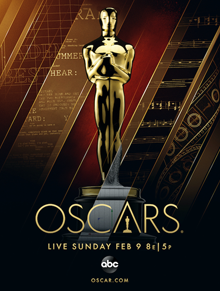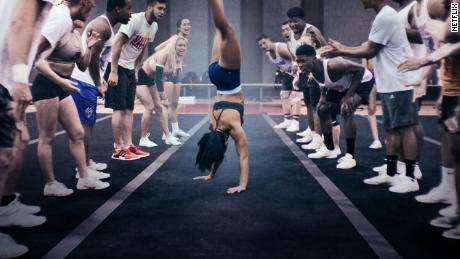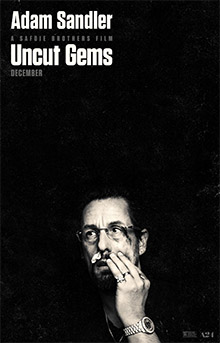This is the seventh annual Pop Culture Scribe Oscars post. Lucky number 7, but given the nominations and how awards season has been going so far, I fear this may be yet another disappointing year in terms of who actually wins. But there were a lot of phenomenal films, and in this post, I shall reward the ones that won my heart, while conceding that they will likely lose to movies that sucked (yeah, I'm talking about you,
Joker). Let's get into it.
Best Picture: The potential frontrunner is
1917. It won the Golden Globe and Producer's Guild Award, has a lot of buzz, is a technical marvel in terms of cinematography but also has the emotional resonance and riveting tension of a World War I plot. Awards voters love British war movies, so this seems inevitable. But then we have
Once Upon a Time in Hollywood, a movie that is quite literally about Hollywood, which awards voters love more than anything. I thought it was long, dull, and full of itself, so given a choice between the two, I would pick 1917 every time. But wait! There's also
The Irishman, a movie that should be catnip to the old, white, male voters that make up the majority of the Academy. Yet another movie I did not enjoy (big surprise), and which has not been winning any awards so far, so it's probably not a favorite. Surprisingly, the Oscars chatter seems to be heating up for
Parasite, one of the rare foreign films to make the leap to the Best Picture race. There's an interesting argument that given the Oscars' preferential voting system, enough people might select Parasite as their #2 pick, which could then ultimately lead to a win. That would be a pretty thrilling finale for this movie season. Parasite is a brilliant movie (if you haven't seen it yet, what are you waiting for?!) and fully deserves the kudos. Unlike Joker, which led the pack with eleven nominations, but I am not going to waste my breath. That movie should not and will not win the Best Picture Oscar. Period. The remaining contenders are
Ford v. Ferrari (a super fun, competent film that is great, but will not win the top prize),
Marriage Story (a splendidly emotional, well-acted, masterpiece of a film that will also not be winning),
Jojo Rabbit (the most unconventional out of all the nominated films, I loved it dearly, but it is far too divisive to win) and
Little Women. Oh Little Women. I would give every Oscar in the world to Little Women if I were in charge. But I'm not, it isn't going to win, and it's an absolute travesty that more people haven't recognized this film for the utterly beguiling and splendiferous marvel it is. So anyway. The nominees for Best Picture are mostly great, but there are some real clunkers in there that reflect there's still much work to do before we stop handing out nominations to any white man with a camera. I will be rooting for a Parasite/Little Women upset, and then politely clap when 1917 sweeps the awards.
Best Director: Let's all agree that this Oscar should go to Greta Gerwig for Little Women. But she isn't nominated, so who should get it instead? I would love for Bong Joon-ho to get it for Parasite. But far more likely is Sam Mendes for 1917. Which is not terrible, but I think that movie is less about the direction and more about Roger Deakins' incredible cinematography to pull off that one-shot trick. The other white men in contention are Quentin Tarantino for Once Upon a Hollywood (he has never won for Directing so might get an Oscar just for that), Martin Scorsese for The Irishman (no, he doesn't need an Oscar for this tedious film), and Todd Phillips for Joker (No. Just NO, goddamnit.)
Best Actress: Renee Zelllweger is the odds-on favorite for her performance in
Judy and I shan't quibble with that. It was an impeccable performance that elevated an otherwise so-so biopic. One could similarly describe Cynthia Erivo's performance in
Harriet, but given the lack of awards buzz around that film, she will likely remain honored to be nominated. Charlize Theron's uncanny performance as Megyn Kelly in
Bombshell was fantastic, but that is more likely to garner a Best Makeup & Hairstyling Oscar than Best Actress. Scarlett Johansson was brilliant in Marriage Story, but ultimately that isn't enough of an over-the-top and sweaty performance that gets Oscar love. And finally, we come to Saoirse Ronan, playing my heroine Jo March in Little Women. This is Ronan's fourth Oscar nomination, but she has yet to win one. I cannot wait to see her finally get a statue because I have been in love with every performance of hers since I first saw her in Atonement. Overall, this is a stacked category, and Zellweger is a deserving winner, but boy would I love an upset by Ronan.
Best Actor: This is guaranteed to go to Joaquin Phoenix for Joker. Which...ugh, but fine. No one who saw that man's ribs poking through his skin in that movie would deny him a statue so that he can just get back to eating cheeseburgers and take acting a bit less seriously. My personal favorite performance in this category is Adam Driver in Marriage Story, which wrecked me in the best way possible. In two hours, that man demonstrated the full range of his acting (and singing!) talent, and it was wonderful. As for the other nominees, I didn't love Once Upon a Time in Hollywood, so I won't be handing any awards to Leonardo DiCaprio, though it was a perfectly serviceable performance. Jonathan Pryce in
The Two Popes was splendid, and at the age of 72, this is his very first Oscar nomination, which is quite sweet. Let's hope he gets another one soon. And Antonio Banderas, I'm so sorry, but I did not see Pain & Glory. So potentially, your performance (also a first nomination!) might be the greatest thing ever captured on film, but I cannot opine.
Best Supporting Actress: This appears to be a shoo-in for Laura Dern who plays the world's most seemingly kind and then cutthroat divorce lawyer in Marriage Story. That would be a well-deserved win and will likely result in a fabulously political acceptance speech that I will enjoy. Her Marriage Story co-star Scarlett Johansson is also nominated in this category for her wonderful work in Jojo Rabbit, which is a lovely and warm performance that I thoroughly enjoyed. Margot Robbie's nomination for Bombshell is equally well deserved, as her performance was the most emotionally resonant and devastating aspect of that film. Florence Pugh's nomination for Little Women is perfect as she singlehandedly redeemed Amy March, a literary character we have collectively hated for hundreds of years. And Kathy Bates was terrific in
Richard Jewell, lending so much heart and depth to that movie. So again, a completely stacked category, where it truly is an honor for all these women to be nominated.
Best Supporting Actor: This is a bizarre category filled with a who's who of men who have been at the top of the acting game for decades. The frontrunner is Brad Pitt for Once Upon a Time in Hollywood, and look, I'm not gonna begrudge the man his award. The scene in that movie when he is shirtless on a roof, basking in the California sun, is indelibly burned into my brain. Sure, give him an Oscar for "acting." Al Pacino and Joe Pesci are obviously great actors, but The Irishman was boring and they will likely split the vote between themselves anyway, so let's move along. Anthony Hopkins was fine in The Two Popes, but given that he basically sounded Welsh instead of German half the time, I am happy to skip him. Which brings us to Tom Hanks, who is the person that clearly deserves this award for his portrayal of Mr. Rogers in
A Beautiful Day in the Neighborhood. He disappeared into that character and made me weep multiple times. Much like I would give Little Women all the awards, give Tom Hanks everything.
Best Original Screenplay: This might go to Parasite, which would be perfectly correct. But I am secretly rooting for
Knives Out, because as a fan of murder mysteries, this was the most delightfully well-constructed mystery written for film. Marriage Story was also a devastatingly good film that I would support. But a win for Once Upon a Time in Hollywood or 1917 would be terribly dull because none of them felt that original and wowed my brain like the other nominees.
Best Adapted Screenplay: All I can do is pray that this is where Greta Gerwig at least wins something for Little Women. And how deserving - she took a novel I have been reading my whole life and made it feel fresh and contemporary and even more meaningful. The screenplay for The Two Popes is not much competition, Joker is not going to win (because I absolutely refuse to let it), and likewise with The Irishman. However, the potential upset comes from Taika Waititi for Jojo Rabbit. In any other year, I would be rooting for that bizarre and wonderful Jojo Rabbit screenplay, but no, Little Women for life.
Those are my thoughts for the major categories. Some other predictions/wishes:
Best Cinematography is a lock for Roger Deakins for 1917. Parasite is 100% winning
Best International Feature Film (formerly known as Best Foreign Film), which is going to make it even more stunning if it also walks away with Best Picture. And Jacqueline Durran thoroughly deserves the
Best Costume Design Oscar for her meticulous work in Little Women. Thomas Newman is nominated for
Best Original Score for 1917, and this is his fourteenth nomination. He has never won, and I have been in love with his film scores ever since his first nomination in 1994 for Little Women (I know, we come full circle!). I would be so delighted if he finally won this year, but the frontrunner appears to be Hildur Guonadottir for her Joker score. Which...sigh.
So that's the 2020 Oscars in a nutshell. I had a great time at the movies this year, but as usual, I'm not holding out hope that the ceremony will award much of that greatness. But maybe we will be surprised. I always go into the Oscars with a combination of weary resignation and a flicker of hope, and sometimes they do something wild to make up for the fact that they didn't nominate any female directors. Fingers crossed! And then we'll regroup on Feb 10 to collect suggestions for 2021.
 Portrait of a Lady on Fire is written and directed by Celine Sciamma, and has a small cast comprised of four women. There are a few men who pop up at the beginning and end, but they are not important. Instead, what we get is a swoony and beautiful two hours of deeply feminine cinema. I'm sure plenty of people have watched the trailers and snarkily summarized it as "the French lesbian movie," but don't fall into that trap. This movie is an ode to all women and their feelings and the gears that grind below the surface. Despite being a period piece set in late 18th century France, these women feel like our contemporaries, incandescent with rage and chafing to live their own lives and be free. In a week when much was made about Elizabeth Warren's debate performance and whether women have the right to show their anger, this is an excellent movie to showcase how little we have moved away from the time when we were corseted and sold into marriages. Sure, we might have more choices now, but nope, we still don't like our women to be angry.
Portrait of a Lady on Fire is written and directed by Celine Sciamma, and has a small cast comprised of four women. There are a few men who pop up at the beginning and end, but they are not important. Instead, what we get is a swoony and beautiful two hours of deeply feminine cinema. I'm sure plenty of people have watched the trailers and snarkily summarized it as "the French lesbian movie," but don't fall into that trap. This movie is an ode to all women and their feelings and the gears that grind below the surface. Despite being a period piece set in late 18th century France, these women feel like our contemporaries, incandescent with rage and chafing to live their own lives and be free. In a week when much was made about Elizabeth Warren's debate performance and whether women have the right to show their anger, this is an excellent movie to showcase how little we have moved away from the time when we were corseted and sold into marriages. Sure, we might have more choices now, but nope, we still don't like our women to be angry..jpg)




